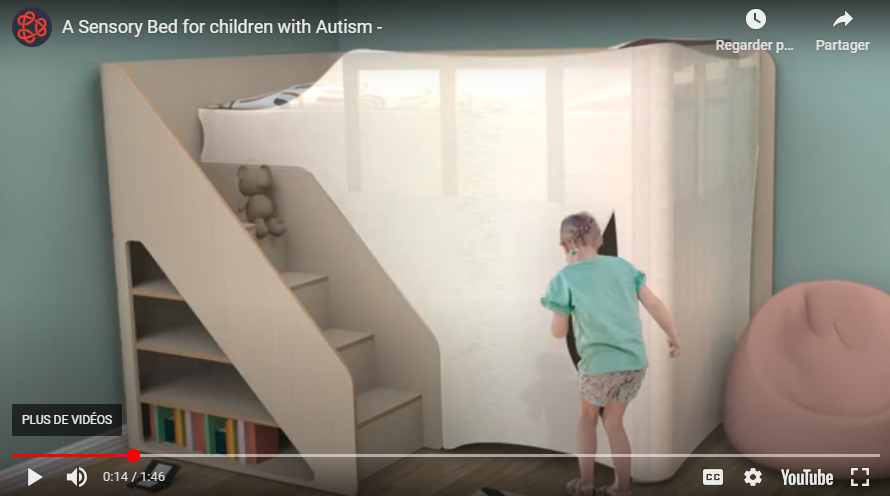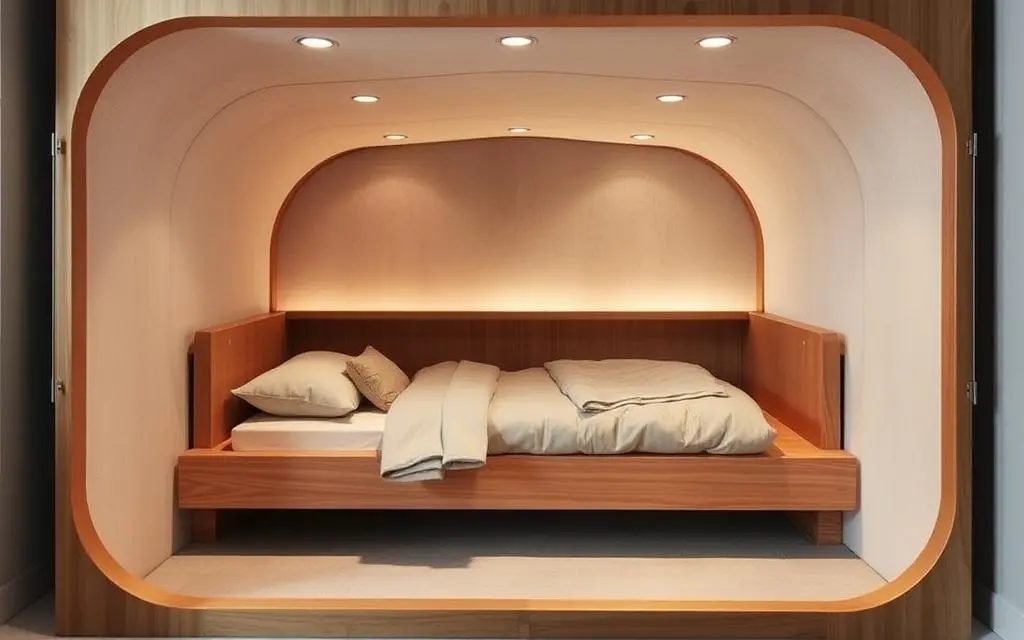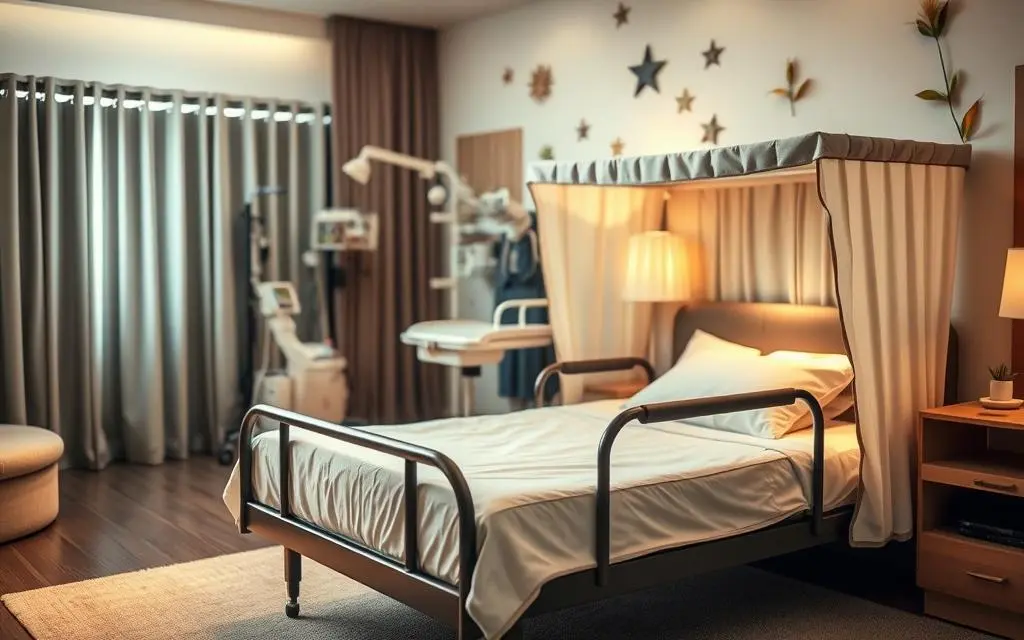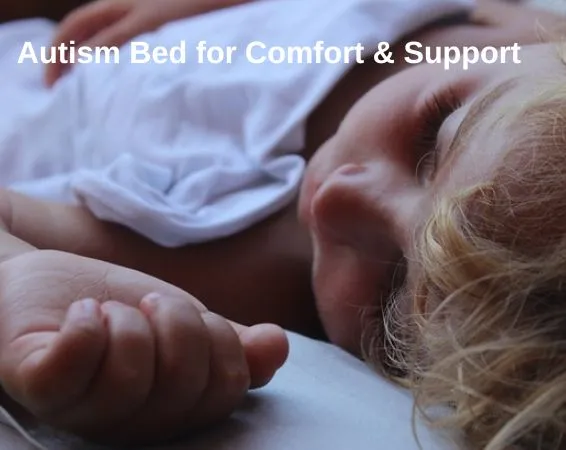Finding the right bed for your child with autism can change their sleep life. Parents of kids with autism know how important it is to have a bed that’s safe, comfy, and supports their senses.
An autism bed is more than just a place to sleep. It’s made to help kids with autism feel safe and supported at night. It tackles the special challenges they face when it’s time to sleep.
We’ve picked out autism beds that create a calm, safe space for your child. They have features like enclosed designs and custom padding. These beds are made to be super comfy and help your child sleep better.
Table of Contents
Key Takeaways
- Specialized beds designed for kids with autism
- Enhanced safety features to stop nighttime wandering
- Sensory-friendly designs for better sleep quality
- Customizable options for individual needs
- Durable construction for long-term use
Understanding Special Needs Sleeping Solutions
Children with autism face special sleep challenges. A sensory bed for autism can make bedtime a cozy place. These beds are made to meet the needs of kids with autism, giving them a safe space.
Sleep is key for kids with special needs to grow. An enclosed bed for special needs has many benefits. It’s more than just a place to sleep.
Benefits of Specialized Beds
- Reduces anxiety and sensory overload
- Provides a sense of security and containment
- Improves sleep quality and duration
- Supports sensory integration
Key Features to Consider
When picking a bed for a child with autism, look for these important features:
- Sensory-friendly materials that don’t irritate the skin
- Enclosed design for emotional comfort
- Adjustable padding for customized support
- Breathable fabrics for temperature regulation
Safety Considerations
Safety is top when choosing a bed. Look for strong build, smooth edges, and secure locks. These ensure your child is safe and feels protected.
“The right bed can transform sleep from a challenge to a peaceful experience for children with autism.” – Pediatric Sleep Specialist
Knowing about these beds helps parents create a safe sleep space. It supports their child’s unique needs.
The Perfect Autism Bed for Your Child’s Needs
Finding the right autism bed can change your child’s sleep and comfort. Every child with autism has different sensory needs. This makes choosing the right bed very important for their health.
When looking at autism bed options, think about these key points:
- Sensory-friendly materials
- Enclosed design for security
- Size and weight specifications
- Safety features
The price of autism beds varies a lot. It can be from $500 to $3,000, based on what you customize and the features. Your budget and your child’s needs will help pick the best bed.
Important things to think about when choosing an autism bed include:
- Look at your child’s sleep habits
- Check their sensory integration needs
- Make sure it’s safe
- Consider how comfortable it is
Specialized autism beds offer a safe, comfy place to sleep. This can greatly improve your child’s rest and life quality.
Investing in the right autism bed is an investment in your child’s comfort and growth.
Safety Features in Enclosed Beds for Special Needs
Keeping a child with autism safe means looking closely at their bed. A special bed offers more than just a place to sleep. It provides safety and comfort tailored for their needs.
Choosing an enclosed bed for special needs requires focusing on safety. Parents need to make sure the bed is both safe and supportive.
Padding and Protection
The right padding is key to preventing injuries and giving a sense of security. Important features include:
- Soft, impact-absorbing wall padding
- Rounded corners to minimize injury risks
- Breathable materials that prevent overheating
- Hypoallergenic fabric options
Lock Systems and Security
Advanced locks are vital for a safe sleep space. Look for:
- Child-proof internal locks
- Sturdy frame construction
- Smooth-operating release mechanisms
- Optional parental monitoring features
“Safety isn’t expensive, it’s priceless” – Unknown
Height Adjustability
Adaptable beds grow with your child, meeting their changing needs. Height-adjustable features offer:
- Flexible sizing options
- Easy caregiver access
- Long-term value
- Customized comfort
Choosing a safety bed for autism means your child gets to sleep well. It also gives parents peace of mind.
Sensory Integration in Autism Beds

Creating the right sensory environment can change sleep for kids with autism. A sensory bed for autism has special features for their unique needs.
Sensory integration is key for kids with autism to feel calm and safe. The right sensory bed offers:
- Deep pressure stimulation
- Weighted blanket options
- Adjustable comfort levels
- Noise-reduction capabilities
Your child’s sensory bed might have cool features like:
- Tactile stimulation materials for gentle touch
- Built-in sound machines with calming white noise
- Soft, breathable fabrics to reduce sensory overload
Customization is important when picking a sensory bed for autism. Every child is different, so finding a bed that fits their needs can greatly improve sleep and comfort.
Sensory integration isn’t one-size-fits-all – it’s about understanding your child’s unique sensory profile.
Therapists say to choose a sensory bed with flexible options. Look for beds with removable parts to adjust as your child’s needs evolve.
Top-Rated Cubby Beds on Amazon
Finding the right autism bed can be tough for parents. They want comfort and safety for their kids. Our list of top-rated cubby beds on Amazon helps you choose wisely.
When looking for the perfect autism bed, price and quality matter a lot. We’ve picked cubby beds that support, secure, and help with sensory issues for kids with special needs.
Product Specifications
- Enclosed bed designs with safety rails
- Padded interior for comfort
- Multiple size options
- Durable construction materials
Customer Reviews and Ratings
Real customer experiences are key. Parents talk about how these beds help with:
- Reduced nighttime anxiety
- Improved sleep quality
- Enhanced sense of security
Price Comparison
Cubby bed prices vary a lot, from $500 to $2,500. Costs depend on:
- Customization options
- Materials used
- Additional safety features
“Investing in the right autism bed can transform your child’s sleep experience.” – Special Needs Parenting Magazine
Even on a budget, you can find good autism beds. Think about how long it will last when looking at prices.
Customization Options for Special Needs Beds

An enclosed bed designed for the special needs of a child, with a cozy, calming interior and subtle customization. The frame is constructed of warm wood, gently curving to create a sense of security. Soft, neutral-toned fabrics line the interior, inviting comfort and relaxation. Subtle lighting emanates from hidden sources, casting a gentle glow that soothes the senses. The bed is elevated slightly, providing a sense of privacy and refuge. Carefully placed sensory features, such as weighted blankets or tactile elements, are seamlessly integrated to address the unique needs of the occupant. An overall atmosphere of tranquility and support, tailored to the individual child’s requirements.
Creating the perfect enclosed bed for special needs children is all about customization. Every child with autism has their own sensory needs. This makes personalized sleep solutions key for their comfort and support.
When picking a sensory bed for autism, look into various customization options. These options should meet your child’s specific needs. Here are some important ones to consider:
- Adjustable Side Heights: Modify bed walls to provide optimal security and comfort
- Sensory Fabric Choices: Select materials that reduce overstimulation
- Color Customization: Choose calming colors that support your child’s visual preferences
- Integrated Weighted Blanket Options: Add therapeutic pressure elements
Companies that make enclosed beds for special needs know how important personalization is. They often offer consultation services. These services help you design a bed that fits your child’s unique needs perfectly.
Some key customization features might include:
- Removable safety padding
- Integrated sensory lighting
- Adjustable mattress firmness
- Sound-dampening technologies
Remember, the right customizations can turn a simple bed into a safe, comforting space for your child with autism.
Maintenance and Care Guidelines
To keep your safety bed for autism in great shape, you need to pay close attention and do regular upkeep. Taking good care of it will make it last longer and keep your child safe and comfy.
Looking after a bed for kids with autism means following some key steps. These steps help keep the bed working well and looking good.
Cleaning Instructions
When you clean your autism bed, you should be gentle but thorough:
- Use mild, hypoallergenic cleaning solutions
- Avoid harsh chemicals that might damage protective surfaces
- Clean fabric parts every month
- Wipe down hard surfaces weekly with disinfectant wipes
Durability Tips
Here are some tips to make your bed last longer:
- Check bed frames every three months for wear
- Regularly check safety mechanisms and locks
- Rotate the mattress every six months for even wear
- Keep the bed away from direct sunlight to prevent damage
Replacement Parts
When parts of your safety bed for autism need to be replaced, follow these steps:
- Contact the original manufacturer for genuine parts
- Keep your bed’s model and serial number handy
- Think about getting an extended warranty for important parts
- Have a professional inspect your bed every year
By being proactive with maintenance, your child’s autism bed will stay safe, comfy, and reliable for many years.
Insurance Coverage and Financial Assistance

Warm, soft lighting illuminates a cozy bedroom setting. In the foreground, a specialized, enclosed bed with high, padded sides sits prominently. The bed is designed for the comfort and safety of individuals with special needs, offering a secure, therapeutic environment. The middle ground showcases medical equipment and assistive devices, hinting at the comprehensive care required. In the background, a soothing, calming color palette, with hints of nature-inspired elements, creates a serene and inviting atmosphere. The overall scene conveys a sense of support, accessibility, and the compassionate consideration of unique needs.
Buying an autism bed or an enclosed bed for special needs can cost a lot. Knowing about insurance and financial help can make it easier for families.
Insurance for special beds varies a lot. Some families might get help paying for it through:
- Private health insurance plans
- Medicaid waiver programs
- State disability support services
- Special education funding
To get financial help, you need to gather a lot of documents. These usually include:
- A doctor’s note saying it’s medically needed
- Reports showing your child has autism
- Details about the bed you want
- Letters explaining why it’s needed
Pro tip: Talk to your insurance company to learn what they need for coverage of special beds.
Many groups offer grants and help for families looking for beds for their kids. The Autism Speaks Family Services Resource Guide can show you where to find this help.
“Financial support is available. Don’t give up on finding the right resources for your child’s comfort and safety.”
Keep talking to your insurance and look at different funding options. This can really help with the cost of an autism bed.
Comparing Different Autism Bed Models
Finding the right sensory bed for autism can be tough. This guide will help you find the best beds for kids with special needs.
When picking a cubby bed, safety, comfort, and sensory needs are key. Think about what your child needs most.
| Model | Price Range | Key Features | Customer Rating |
|---|---|---|---|
| SafeSleep Sensory Bed | $799-$1,099 | Enclosed designWeighted blanket optionPadded walls | 4.7/5 stars |
| Comfort Zone Cubby Bed | $599-$899 | Adjustable heightBreathable mesh sidesPortable design | 4.5/5 stars |
| Secure Sleep Special Needs Bed | $899-$1,299 | Advanced locking systemSensory-friendly materialsCustomizable interior | 4.8/5 stars |
When looking at cubby bed prices, remember that a good sensory bed can really help your child sleep better. It’s worth the investment for their comfort.
- Think about what you need
- Look at warranty options
- Read what other customers say
Each bed has special features for kids with autism. Look closely at the details to find the best fit for your child.
Sleep Safety Tips for Children with Autism
Creating a safe sleep space for kids with autism needs careful planning. The right bed is key to a secure bedtime routine. It helps your child feel safe and comfortable at night.
A special bed can lower anxiety and safety risks. Beds with enclosed designs offer a sense of security. It’s important to reduce sensory triggers and have a consistent bedtime routine that meets your child’s needs.
Creating a Calming Environment
Make a sleep area that avoids too much stimulation. Use soft bedding and consider weighted blankets for gentle pressure. Dim lights and quiet techniques help your child sleep better.
Your autism bed should be in a quiet spot, away from light and noise.
Bedtime Routine Strategies
Consistent routines are vital for kids with autism. Create a predictable bedtime sequence, like gentle stretches or quiet music. Include your safety bed in this routine to make your child feel secure and ready for sleep.
Emergency Preparedness
Always have a safety plan ready. Keep emergency numbers handy and make sure your bed has safety features like locks and padding. Practice emergency drills with your child when they’re calm to build confidence.
Discover our post: 10 Tips to Improve deep Sleep : Advice and strategies
Amazon products:
Secure Sleep Special Needs Bed
This article contains affiliate links. Some links on this page are affiliate links. if you purchase through them, I receive a small commission, which helps me keep cratingfree content.Thank you for support.
What makes a bed suitable for children with autism?
FAQ
A good bed for kids with autism has features like sensory-friendly materials and enclosed sides. It also has padded walls and can be customized. These beds help create a calm space that reduces anxiety and improves sleep.
How much do specialized autism beds cost?
Prices for autism beds vary from $1,500 to $5,000. This depends on the features, size, and how much you can customize it. Basic beds start at $1,500, while advanced models with more features can cost up to $5,000 or more.
Are these beds covered by insurance?
Insurance coverage for autism beds can vary. Some plans and special needs programs might help pay for them. You’ll need a doctor’s note and a prescription to make an insurance claim.
What safety features should I look for in an autism bed?
Look for padded walls, secure locks, and adjustable height. Also, check for low-profile design, rounded edges, and strong structure. Soft, breathable materials and safety certifications are important too.
Can these beds be customized for my child’s specific needs?
Yes, many beds can be customized. You can choose specific sensory elements, colors, and add padding. You can also get integrated lighting, sound machines, and adjustable parts to fit your child’s needs.
How do I clean and maintain an autism bed?
Clean the bed with hypoallergenic solutions and wash removable covers. Check the bed’s structure and safety features regularly. Always follow the manufacturer’s care instructions.
What are the benefits of an enclosed bed for a child with autism?
Enclosed beds offer security, less sensory input, better sleep, and less anxiety. They create a safe space that helps children with autism feel calm and supported during sleep.
How do I know which size bed to choose?
Think about your child’s size, growth, and needs. Many beds come in different sizes and have adjustable parts. Measure your child and talk to the manufacturer to find the right size.
Are there portable options for autism beds?
Yes, some beds are lightweight and easy to move. They can be set up and taken down quickly. These are great for families who travel a lot or need flexibility.
Can these beds be used by children with other special needs?
Yes, many autism beds are good for kids with other special needs too. This includes sensory processing disorders, ADHD, and anxiety. These beds help create a controlled sleep environment that benefits many children.
